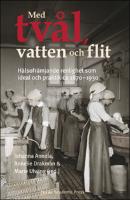Med tvål, vatten och flit
Hälsofrämjande renlighet som ideal och praktik, ca 1870–1930
| dc.contributor.editor | Annola, Johanna | |
| dc.contributor.editor | Drakman, Annelie | |
| dc.contributor.editor | Ulväng, Marie | |
| dc.date.accessioned | 2021-12-16T10:19:41Z | |
| dc.date.available | 2021-12-16T10:19:41Z | |
| dc.date.issued | 2021 | |
| dc.identifier | ONIX_20211216_9789188661975_12 | |
| dc.identifier | OCN: 1291607791 | |
| dc.identifier.uri | https://library.oapen.org/handle/20.500.12657/52056 | |
| dc.language | Swedish | |
| dc.subject.classification | thema EDItEUR::J Society and Social Sciences::JB Society and culture: general::JBC Cultural and media studies::JBCC Cultural studies::JBCC9 History of ideas | en_US |
| dc.subject.classification | thema EDItEUR::J Society and Social Sciences | en_US |
| dc.subject.classification | thema EDItEUR::N History and Archaeology::NH History | en_US |
| dc.subject.other | Labour | |
| dc.subject.other | Gender | |
| dc.subject.other | Nordic countries | |
| dc.subject.other | Late 19th century | |
| dc.subject.other | Health | |
| dc.subject.other | Cleanliness | |
| dc.title | Med tvål, vatten och flit | |
| dc.title.alternative | Hälsofrämjande renlighet som ideal och praktik, ca 1870–1930 | |
| dc.type | book | |
| oapen.abstract.otherlanguage | With soap, water, and diligence discusses attitudes and practices around cleanliness and health at the turn of the nineteenth and twentieth centuries. At this time, scientific findings on how diseases spread had rendered both the body and the home as particularly risky in terms of the health of an individual. However, the zeal for cleaning was more than just a health issue – it also contributed to societal change at large. This book aims at deepening our understanding of cleanliness in relation to social class, gender, work, consumption, and space, viewed from a Nordic perspective. The battle against dirt was fought on a broad front, and on different levels of society. The book at hands offers glimpses of the long and complex societal process which was required for the Nordic societies to grow cleaner over time. Behind the gradually increasing interest in soap and lather lay challenges, negotiations, and disagreements about the ways in which cleanliness should be advanced, and who would be the ones advancing it. To establish the supremacy of soap required a lot of hard work. The ten chapters shed light on the interaction between debaters, voluntary associations, institutions, and individuals. How was cleanliness promoted and what was the reception like? Who and what was to be cleaned, and on which terms? What did cleanliness mean in different contexts and for different individuals? The book makes both ideals and practices visible by exploring the ways in which the gospel of cleanliness was presented, propagated, understood, questioned and renewed, and also by showing that in some cases people’s quest for cleanliness had motivations other than those intended by the promoters. The chapters have been written by economic historians, ethnologists, social historians, and historians of ideas from Denmark, Finland, Norway, and Sweden. The book is intended for students, scholars and the general reading audience interested in a social historical perspective on cleanliness. | |
| oapen.identifier.doi | 10.21525/kriterium.33 | |
| oapen.relation.isPublishedBy | 7b034f4a-b816-4718-88ac-63b24c8e4b24 | |
| oapen.relation.isbn | 9789188661975 | |
| oapen.relation.isbn | 9789188909961 | |
| oapen.imprint | Kriterium | |
| oapen.pages | 285 | |
| oapen.place.publication | Gothenburg |

